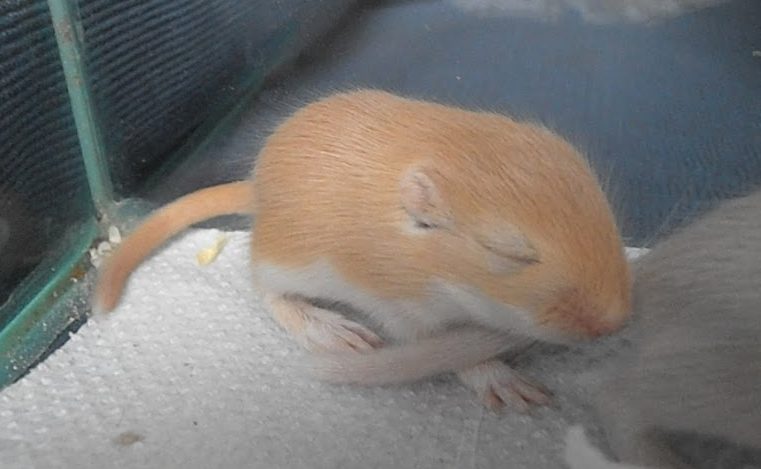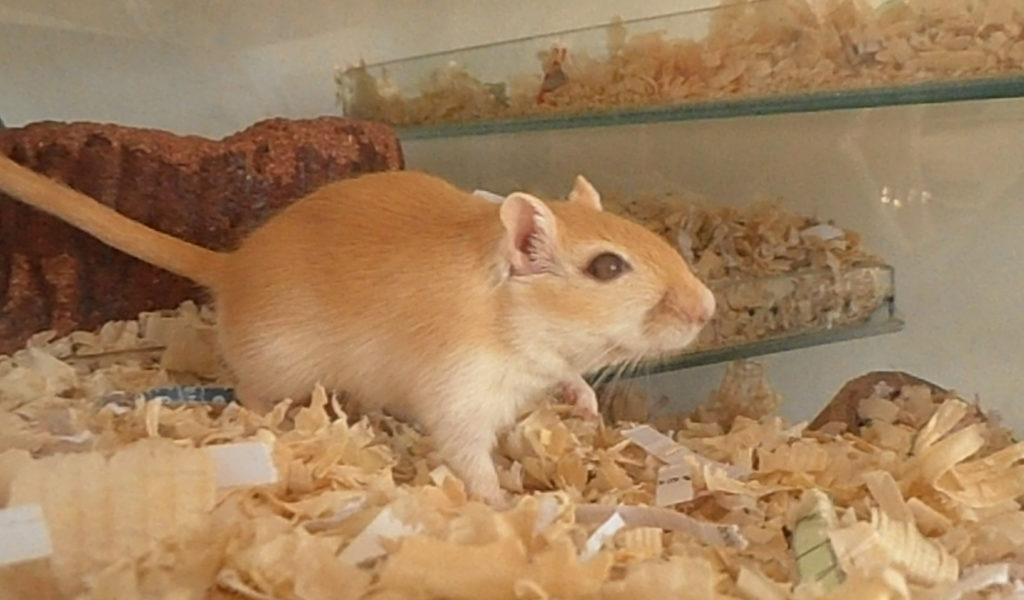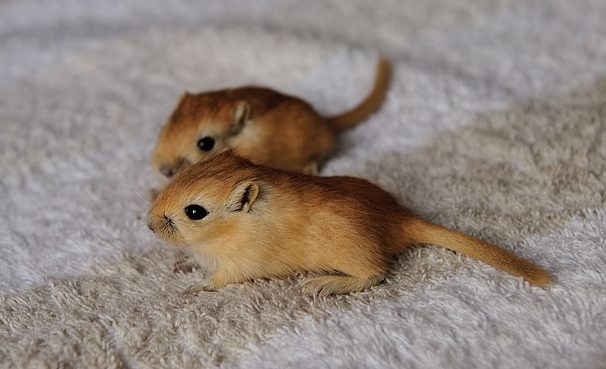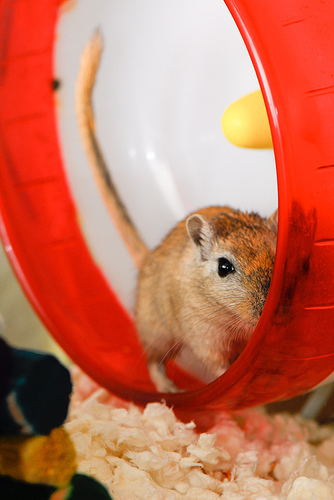Well, technically (genetically) there are 51 different standard* combinations of genes that will create a gerbil that is ginger on the outside!
Wow – that really was more than we thought ourselves!
So how come so many? Well if you do the FULL** genetic combinations there will be 8 times that – but of course, most people will only ‘see’ the different gingers (not the genes hidden inside) – so I suppose for pet gerbil purposes – there are only 5 main ginger gerbil groups:
- Argente
- Dark-Eyed Honey (DEH)
- Red-Eyed Honey (REH)
- Nutmegs
- Saffrons (Red Fox)
There are also Schimmels (molds) which are a fading version (instead of of just e they have ef – with f for fading) of all the colors above (not including the argentes) who are only ginger as pups – but turn white as adults (pretty awesome really).
*standard – in this sense it means only the key genes that determine a ginger color. So for example – aa ee – is all you need to create a nutmeg (assuming that no other recessives are doubled up – because – aa ee pp – makes the gerbil a saffron instead).
**full – in this sense means every single gene in the gerbils genotype – even if it isn’t needed to create the ginger color. So, a nutmeg is a nutmeg – but genetically it could be:
- aa CC ee PP UwUw
- aa CC ee Pp UwUw
- aa CC ee PP Uwuwd
- aa CC ee PP Uwuw
- aa CC ee Pp Uwuwd
- aa CC ee PP Uwuw
- aa Cch ee PP UwUw
- aa Cch ee Pp UwUw
- aa Cch ee PP Uwuwd
- aa Cch ee PP Uwuw
- aa Cch ee Pp Uwuwd
- aa Cch ee PP Uwuw
- aa Ccchm ee PP UwUw
- aa Ccchm ee Pp UwUw
- aa Ccchm ee PP Uwuwd
- aa Ccchm ee PP Uwuw
- aa Ccchm ee Pp Uwuwd
- aa Ccchm ee Pp Uwuw
I think that is all of them?
- aa CC eef PP UwUw
- aa CC eef Pp UwUw
- aa CC eef PP Uwuwd
- aa CC eef PP Uwuw
- aa CC eef Pp Uwuwd
- aa CC eef Pp Uwuw
- aa Cch eef PP UwUw
- aa Cch eef Pp UwUw
- aa Cch eef PP Uwuwd
- aa Cch eef PP Uwuw
- aa Cch eef Pp Uwuwd
- aa Cch eef Pp Uwuw
- aa Ccchm eef PP UwUw
- aa Ccchm eef Pp UwUw
- aa Ccchm eef PP Uwuwd
- aa Ccchm eef PP Uwuw
- aa Ccchm eef Pp Uwuwd
- aa Ccchm eef Pp Uwuw
Anyway – Let’s look at the details for these gingers:
Ginger Gerbils 1: Argente Colors
There are three versions of ginger that can be seen with the naked eye in the Argente family (their phenotype (pheno = showing)). The intensity of the ginger depends on what gene the second C gene is that they have in their genetic make-up – their genotype (geno = genes):
Argente Golden: CC – this colour is bright ginger (no dilution at the c point/locus)
Argente Fawn: Ccchm – this color is a bit lighter than the Golden as has partial dilution (image)
Argente Cream – Cch – this color is a very light ginger as has full dilution
All these ginger gerbils have a full white tummy that you can just about see along their tummies if they have all 4 feet on the ground. Like a white petticoat.
These colours are all on the Agouti-side (A*) – and are all technically pink-eyed agoutis. So you can’t get a dark eyed argente (as it would just be a normal agouti?).
Their equivalent colors on the self side (aa) are Lilac (CC), Sapphire (Ccchm) and Dove (Cch).

Ginger Gerbils 2: The Honeys
The next groups of ginger gerbils are what are known as the Honeys and have the double ee gene – the extension of yellow (hence their ginger coats). Due to different genetics to the argentes – these honeys can have both dark or pink eyes.
Dark-Eyed Honey (DEH) – they have a lovely rich dark ginger coat and high white tummy
Red-Eyed Honey (REH) – they have a more-intense ginger coat with bright pink eyes
You can tell these apart from the argentes by the amount of white you can see when they have all 4 feet on the ground. Unlike the petticoat effect of the argentes, the honeys have white right up their sides – almost half way up. They also have pale rings around their eyes.
These colours though, can still be affected by the colorpoint genes at their C locus – and it lightened the coat slightly, just as it does in argentes. So a DEH with Ccchm or Cch will be lighter than one with CC – and as such they are often called Light Dark-Eyed Honeys (LDEH) or Light Red-Eyed Honeys (LREH).
Additionally, as mentioned earlier, there are schimmel genes linked to the recessive e gene that makes a honey – and if the DEH or REH has one of these – it will also be slightly lighter and may well fade considerably as it ages. It won’t go totally white though as it doesn’t have the full double dilution.

Ginger Gerbils 3: The Nutmegs
Genetic self twins to the honeys are the nutmegs (even though they don’t have matching names). The pairing to the DEH is the Nutmeg and the pairing to the REH is the Saffron (or using the old name; Red Fox) – basically a pink-eyed Nutmeg genetically.
Nutmeg – they have a lovely full ginger coat as pups, but it goes black in places as they age
Saffron – these are bright ginger gerbils with no white on them at all (unless they are spotted)
Just like with the honeys – if they carry a colorpoint gene they will be paler and can be called a Light Nutmeg and a Light Saffron.
Just like with the honeys – they can carry the schimmel gene and be paler.
One thing not linked though is how many black patches appear on your nutmeg and how dark they are. Some Nutmegs can stay ginger way past a year, some go really dark black at their 12 week molt. We are not sure if there is any way to determine who will do what?


Please follow these links to find out more about the ginger colours and to see images of each:
Argente Golden – see color page
Argente Fawn – see color page
Argente Cream – see color page